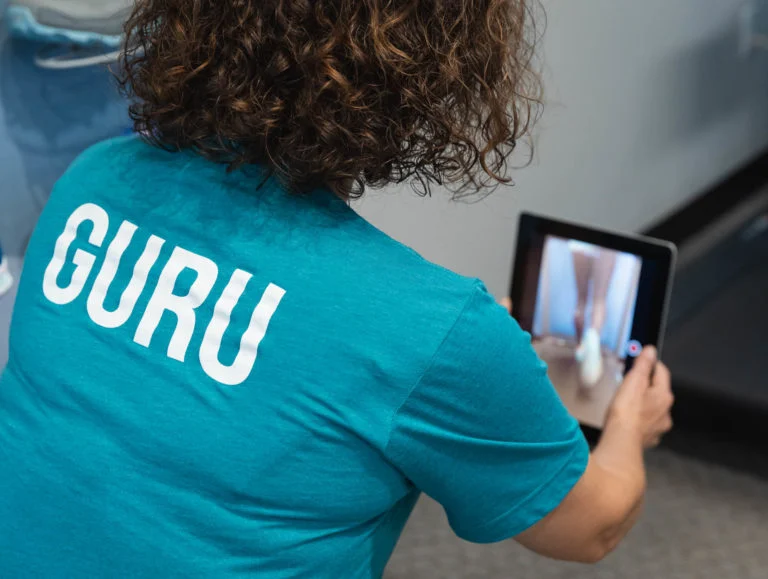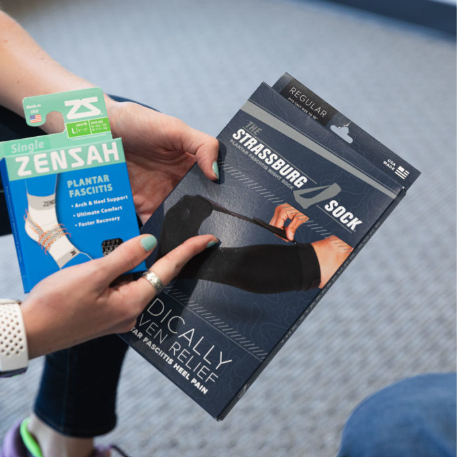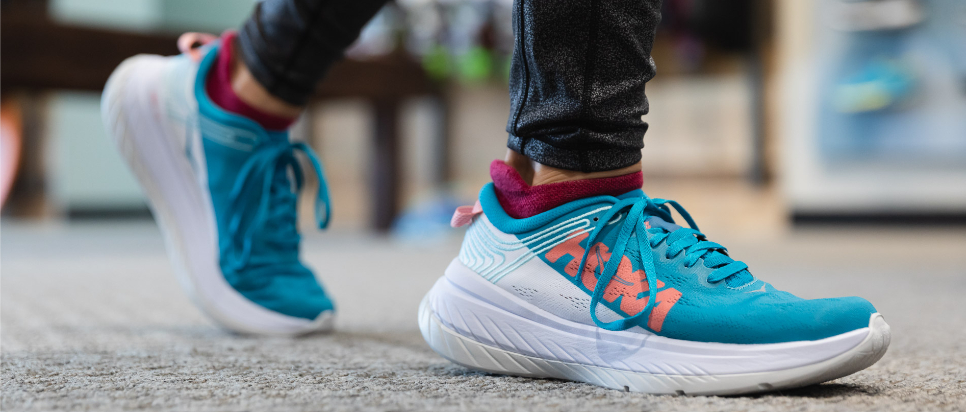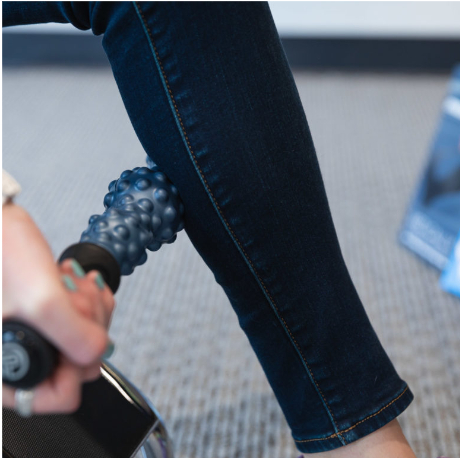It may feel like you'll never recover—but there is hope
Did you wake up this morning and upon taking that first step, feel an extremely sharp pain in your heel?
That is the telltale sign of Plantar Fasciitis. It’s one of the most common injuries we see at The Running Well Store, as well as among the most common causes of heel pain. It is the result of an inflammation of the thick band of tissue (or fascia) that runs across the bottom of your foot and connects your heel bone to your toes. The Running Well Store has some key exercises and products we recommend to overcome this injury.


About Plantar Fasciitis
Your plantar fascia supports the muscles and arch of your foot and when it is overstrained, you can get tiny tears. The condition of your Plantar Fascia being inflamed is called Plantar Fasciitis.
Plantar Fasciitis typically causes a stabbing pain in the bottom of your foot near the heel. The pain is usually the worst with the first few steps taken after awakening, although it can also be triggered by standing or walking after prolonged sitting. The pain is usually more intense after exercise, not during it.
To help heal this fascia, you typically read online about arch supports, arch exercise, applying ice and resting the foot. However, the foot is only one piece in the pain puzzle. The key to kicking Plantar Fasciitis to the curb is to treat the foot AND the calf muscle.
The calf muscle runs down the back of your leg and connects at the heel, to the same bone as your plantar fascia connects. When your calf muscle is tight, it pulls on the plantar fascia creating more tension and aiding in inflammation.
For most people, plantar fasciitis improves when they massage and stretch their calf muscle, and rest, stretch, and strengthen their arch.
Tips for how to treat Plantar Fasciitis
At The Running Well Store, we look beyond the area that your sock covers. We help provide tools to rest your arch and stretch your calf muscle. The good news is that you can overcome Plantar Fasciitis without breaking the bank!
One of the biggest things to remember is to not cross your fingers and hope it will go away. Plantar Fasciitis will not go away on its own. It’s like that annoying fly that keeps buzzing your picnic – unless you smack it with a flyswatter, it’ll keep coming back. Since it is often caused by tight calf muscles AND lack of support in the arches, we recommend a one-two punch.



Focus on the Calf Muscle
If you have a caffeine headache and you take a pain reliever, you are treating the symptoms, but when you remove the caffeine from your diet, the caffeine headache goes away. This is an important analogy because a common suggestion for Plantar Fasciitis Relief is a good pair of orthotics. Yes, the orthotics help relieve the pain, but they do not remove the cause of the injury: tight calf muscles.
Tight calf muscles affect your gait by limiting your foot and ankle’s range of motion. When your calf is tight, it pulls on your Achilles tendon and creates tension on the plantar fascia. Tight calf muscles can also form bone spurs on back of the heel or on the bottom of the heel.
Tight calf muscles can be the culprit behind other lower leg issues. Problems like Achilles Tendonitis, shin splints, knee pain and even hip and back pain can originate with tight calf muscles.
Exercises that can help Plantar Fasciitis
When someone experiencing heel pain comes in The Running Well Store, we instantly talk about their calf muscle and what we can do to help. We recommend these exercises for Plantar Fasciitis.
Massage
- A Stick Roller: this provides a pinpoint massage to those tender spots in your calf muscle. You control the pressure and duration. Do this three times a day for relief.
- Foam Roll the calf muscle: When we demonstrate how to use the foam roller with our clients, they are always amazed to learn how tight their calf muscle is. For someone battling Plantar Fasciitis we recommend foam rolling the calf muscle at least three times a day.
Wall Stretch
- Stand arm’s length from a wall.
- Place your right leg behind your left, slowly and gently bend your left leg forward.
- Keep your right knee straight and your right heel on the ground.
- Hold stretch for 15 to 30 seconds and release. Repeat 3 times. 5) Switch lead leg and repeat.
Leg Stretch
- Sit on the floor with one leg straight and one leg folded in towards your body
- Wrap a belt, a yoga strap or another type of band around your straight foot holding the ends of the strap in your hands.
- Gently pull your body towards your foot.
- Repeat 3 times and switch lead leg.
Step Stretch
- Find a step.
- Stand on a small step, letting the heel of the leg drop to be stretched hang off the back of the step
- Drop the heel down by bending the other knee until you feel a stretch in the back of your calf and the sole of your foot.
- Hold for 30 seconds and repeat 3 times a day.
*It is important to implement the step stretch into your routine, but do not overdo it!
Focus on the Foot
Now that we know that a tight calf muscle causes Plantar Fasciitis, let’s also work on also treating the pain! Because the plantar fasciitis runs the length of your arch, you are going to need to let it rest and heal. But since we live life and can’t stay off our feet, here are our recommendations:
Arch Support
Everyone pronates! Pronation is the natural movement of the foot as it rolls inward while walking or running. This movement absorbs shock by distributing the impact forces generated from the ground. When we pronate it causes our arches to move, causing your plantar fascia to move which can aggravate the inflamed tissue. If you had a broken arm, you would have it cast. An arch support is a cast for your injured arch. What an arch support will do is minimize the movement of the arch so that your plantar fascia can rest as you walk around throughout the day.
- Important Notice: These do not need to be expensive! The Running Well Store has some great options, with a 100 day guarantee, that cost approximately $45. We always recommend starting with these before going with a custom orthotic.
- Something to consider: When you wake up in the morning and put your rested feet on the floor to stand, your pronation is causing that pain in your heel. We recommend some of our OOFOS or Spenco sandals to slip into before getting out of bed. The Spenco and OOFOS sandals are soft and cushy and have arch supports to help ease your feet into the day.
Sleeping
Sleeping is an important process for the body, it is a time when we recover from the day. This includes any injuries. When we sleep our feet naturally relax and the fascia shortens. To help it stay stretched throughout the night, we recommend the Straussburg Sock. It is not the most attractive item, but it really does the trick. It keeps the foot bend at a 90-degree angle so the plantar facia does not shorten overnight.
Strength & Flexibility
Stretches and exercises for your foot can help plantar fasciitis by relieving pain, improving muscle strength, and promoting flexibility in the foot muscles and ligaments.Foot Strength Marbles
Don’t lose your marbles! Pick them up. Large screws or bolts will also work. Put the marbles on the floor next to a cup and using your toes, try to lift the marbles up from the floor and put them in the cup.Foot Strength Towel Curls
While sitting, place your foot on a towel on the floor and scrunch the towel toward you with your toes. Focus on one foot, then switch to the other foot.Foot Stretch
To stretch the tightness in the plantar fascia, try: 1.) Sitting in a chair, cross the injured heel over the other leg, 2.) Hold the foot in your opposite hand, 3.) Pull the toes toward the shin to create tension in the arch of the foot 4.) Place the other hand on the bottom of the foot to feel for tension in the plantar fascia.Plantar Fasciitis Advice from the Experts
Self-treatment for plantar fasciitis includes stretching, icing, anti-inflammatory medication such as Aleve or Ibuprofen, supportive shoes, and arch supports. One should also avoid going barefoot. I would recommend seeing a podiatrist if symptoms are not improving after three weeks of self-treatment.
Dr. Michael Fine,
Podiatrist
Fine Foot Centers
http://www.finefootcarecenter.com/

Not sure where to start?
The road to recovery is best run cautiously and patiently.
If you live in Kansas City, have Plantar Fasciitis and are seeking premium products to help find relief from your pain, The Running Well Store can help. Schedule a fitting online or simply give your nearest location a call and we’ll provide personalized recommendations to get you back to your fitness goals.
Frequently Asked Questions
How long does Plantar Fasciitis last?
Some people struggle with Plantar Fasciitis going away only to return in a vicious cycle. The key to overcoming this injury involves resting the arch and stretching the calf muscle. The more you dedicate time to stretching and rolling the calf and the more vigilant you are with your arch supports the quicker the injury resolves.
Do you recommend cortisone shots?
We see a lot of clients who are so incredibly frustrated with the continual pain of Plantar Fasciitis that they are considering cortisone shot. This is understandable, given how frustrating and painful this injury can be. It is important to note that cortisone shots are not a long-term solution. It is imperative that when you get the shot, you rest your foot and still roll out your calf muscle. We recommend cortisone shots as a last-ditch effort, but all medical decisions should be discussed with your doctor.
Is there an easy or quick way to make Plantar Fasciitis go away?
Unfortunately, no. It takes work to make this injury go away and stay away. There is no magic pill. Relieving the tightness in your calf muscle and resting, stretching, and strengthening the foot is going to be the only way you can rid yourself of Plantar Fasciitis and make it stay away.





